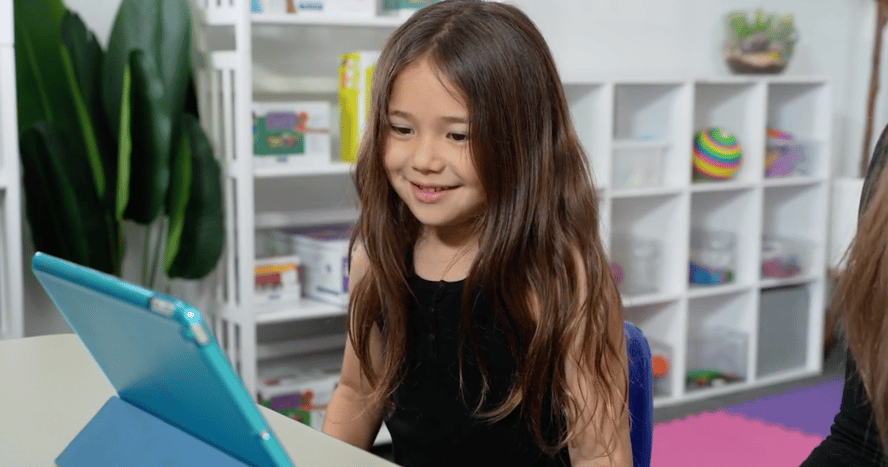
Teletherapy for autism, also called distance learning or remote learning for autism, has proven to be an extremely useful tool for training ABA therapists and, in some cases, for delivering therapy to autistic children.
With the significant rise in autism diagnoses and clear research continuing to stress the importance of early intervention for autistic children to improve long-term outcomes, the U.S. faces a critical shortage of ABA therapists.
ABA therapists use data to increase behavioral skill acquisition while working to reduce problem behaviors. These rockstar service providers are highly trained in ABA principles and can help children learn critical skills like behavior management, communication, and toilet training along with other verbal, adaptive, and functional skills. While this all sounds amazing, a challenge lies ahead: not enough therapists to meet the demand to provide these services for autistic children.
 There are screen after screen of openings posted online for ABA therapist positions. Many need to work in clinical settings, which are more common in metropolitan areas. But if you—and children in need of teaching support—don’t live near a clinic or ABA therapist, how can these professionals reach children in need? Even for those who live near an ABA therapist, there is such a high demand for services, that it casts doubt on whether someone in need can secure an appointment at the clinic.
There are screen after screen of openings posted online for ABA therapist positions. Many need to work in clinical settings, which are more common in metropolitan areas. But if you—and children in need of teaching support—don’t live near a clinic or ABA therapist, how can these professionals reach children in need? Even for those who live near an ABA therapist, there is such a high demand for services, that it casts doubt on whether someone in need can secure an appointment at the clinic.
Enter teletherapy. Despite the obvious downsides of the COVID-19 pandemic, people had to get creative to provide services when in-person wasn’t an option. Pivoting to Zoom, therapists learned quickly to make the most of these online therapeutic interactions, and the research findings demonstrate that telehealth can be very effective and achieve the same results as in-person ABA therapy.
What Is Teletherapy?
Teletherapy, also called Telehealth, is the delivery of healthcare services from providers to patients across some distance through the Internet. Teletherapy can enable diagnoses, treatment, and the delivery of early intervention services through the use of such technology as live-streamed video or interactions via online multimedia platforms designed specifically for therapy.
How Can Telehealth Support Autistic Students?
1. Autistic students can make real growth and progress through teletherapy.

When the country shut down for COVID-19 and the “normal” world stopped, the big question was, how can we keep providing much-needed ABA services to autistic children? Many therapists improvised and pushed forward with teletherapy to provide services despite the many unknowns, especially among children with more severe needs. The resulting research data shows autistic students and their families can thrive in this medium.
After initial parent training on this intervention process, clinicians have been able to coach, teach, and provide feedback on interventions parents can use with their children to accelerate progress in skill development. Remarkably, many autistic students have maintained their level of progress even in an electronic format. Though research is still in the early stages, we are seeing marked gains in maintenance and generalizing of skills.
2. Higher levels of engagement and a range of reinforcement options through technology.
Especially since the pandemic, studies show parents have demonstrated a high interest in web-based platforms. The necessity of receiving help in this way has shown it can be an effective way to deliver ABA interventions and hold student attention.
Clinicians often rely on a small reinforcement after a session, a favorite toy, or access to some kind of device, but the problem that always comes up is space. Varying the reinforcements helps ensure the student doesn’t “burn out” on any particular thing, which would negate the motivating impact. Services provided by teletherapy allow for a wide range of interactive features with positive reinforcement, and access to preferred video clips or graphics to give feedback while reserving control when it is time to move back to working in person.
Online prompting such as highlighting, picture wiggling, verbal cues, fading visual cues like arrows, or narrowing the field through shading on the screen—these all mimic in-person instruction and increase teletherapy student success. Features like these help students stay engaged and build positive momentum.
3. Teletherapy helps build capacity for families.
The truth is that autistic children do not live in a clinic; they live with their families. Especially with limited access to ABA supports, telehealth can allow for trained professionals to see the home setting, watch how parents are intervening to give feedback—and then help build up their skills so that families can keep providing better-specialized support for their children. Being able to “pass the baton” to family members to act as interventionists can be very empowering and help the autistic child recognize consistency in responses across individuals and settings, which will help them gain and retain skills and learning. Research consistently shows success in parent-mediated interventions for serving autistic children, particularly in behavioral and communication techniques.
Studies show that building up parents’ skills reduces their stress levels with help from tele-assisted instructions and interventions. That makes sense as their child continues to develop skills and decrease challenging behavior at home as they build competencies.
4. ABA therapists can serve more students sooner, regardless of location.
 Most importantly, getting services to a student in need should not be dependent on a zip code. Telehealth closes the inequity gap in therapy services for autistic students. When they need immediate support, telehealth can put it one click away for families, even in the most remote areas of the country.
Most importantly, getting services to a student in need should not be dependent on a zip code. Telehealth closes the inequity gap in therapy services for autistic students. When they need immediate support, telehealth can put it one click away for families, even in the most remote areas of the country.
There is also the practicality of providing services via technology. The limits of time and number of ABA therapists create a logistical challenge of traveling from site to site for the therapist. Some therapists in rural areas spend almost half their time traveling between schools, clinics, or families. It is also challenging for families to transport a child for an hour or more to ensure that their autistic child gets support. Indeed, some autistic children do not travel well and experience anxiety after long trips, so having the comfort of home while learning invaluable skills rather than transitioning to a new, strange setting can have tremendous benefits. Telehealth can address the shortage of providers and increase their ability to serve all students in need. Moreover, recent research shows it can be just as effective as in-person services for autistic students.
Learn more about the STAGES® Learning Line Online Teletherapy Platform
What has been your experience with teletherapy? Are there any other positive or negative points you have experienced through telehealth that may shed light on this discussion?
References
Boisvert, M., & Hall, N. (2014). The use of telehealth in early autism training for parents: a scoping review. Smart Homecare Technology and TeleHealth, 19. https://doi.org/10.2147/shtt.s45353
Marino, F., Chilà, P., Failla, C., Crimi, I., Minutoli, R., Puglisi, A., Arnao, A. A., Tartarisco, G., Ruta, L., Vagni, D., & Pioggia, G. (2020). Tele-Assisted Behavioral Intervention for Families with Children with Autism Spectrum Disorders: A Randomized Control Trial. Brain Sciences, 10(9), 649. https://doi.org/10.3390/brainsci10090649
McClain, M. B., Shahidullah, J. D., & Mezher, K. R. (2020). Interprofessional Care Coordination for Pediatric Autism Spectrum Disorder. Springer Publishing.





